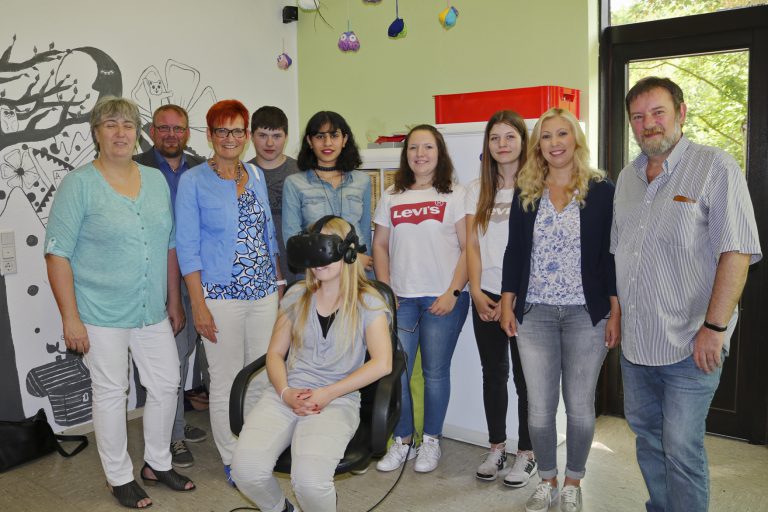by Michael E. Porter and James E. Heppelmann
There is a fundamental disconnect between the wealth of digital data available to us and the physical world in which we apply it. While reality is three-dimensional, the rich data we now have to inform our decisions and actions remains trapped on two-dimensional pages and screens. This gulf between the real and digital worlds limits our ability to take advantage of the torrent of information and insights produced by billions of smart, connected products (SCPs) worldwide.
Augmented reality, a set of technologies that superimposes digital data and images on the physical world, promises to close this gap and release untapped and uniquely human capabilities. Though still in its infancy, AR is poised to enter the mainstream; according to one estimate, spending on AR technology will hit $60 billion in 2020. AR will affect companies in every industry and many other types of organizations, from universities to social enterprises. In the coming months and years, it will transform how we learn, make decisions, and interact with the physical world. It will also change how enterprises serve customers, train employees, design and create products, and manage their value chains, and, ultimately, how they compete.
In this article we describe what AR is, its evolving technology and applications, and why it is so important. Its significance will grow exponentially as SCPs proliferate, because it amplifies their power to create value and reshape competition. AR will become the new interface between humans and machines, bridging the digital and physical worlds. While challenges in deploying it remain, pioneering organizations, such as Amazon, Facebook, General Electric, Mayo Clinic, and the U.S. Navy, are already implementing AR and seeing a major impact on quality and productivity. Here we provide a road map for how companies should deploy AR and explain the critical choices they will face in integrating it into strategy and operations.
What Is Augmented Reality?
Isolated applications of AR have been around for decades, but only recently have the technologies required to unleash its potential become available. At the core, AR transforms volumes of data and analytics into images or animations that are overlaid on the real world. Today most AR applications are delivered through mobile devices, but increasingly delivery will shift to hands-free wearables such as head-mounted displays or smart glasses. Though many people are familiar with simple AR entertainment applications, such as Snapchat filters and the game Pokémon Go, AR is being applied in far more consequential ways in both consumer and business-to-business settings. For example, AR “heads-up” displays that put navigation, collision warning, and other information directly in drivers’ line of sight are now available in dozens of car models. Wearable AR devices for factory workers that superimpose production-assembly or service instructions are being piloted at thousands of companies. AR is supplementing or replacing traditional manuals and training methods at an ever-faster pace.
More broadly, AR enables a new information-delivery paradigm, which we believe will have a profound impact on how data is structured, managed, and delivered on the internet. Though the web transformed how information is collected, transmitted, and accessed, its model for data storage and delivery—pages on flat screens—has major limits: It requires people to mentally translate 2-D information for use in a 3-D world. That isn’t always easy, as anyone who has used a manual to fix an office copier knows. By superimposing digital information directly on real objects or environments, AR allows people to process the physical and digital simultaneously, eliminating the need to mentally bridge the two. That improves our ability to rapidly and accurately absorb information, make decisions, and execute required tasks quickly and efficiently.
Explore Augmented Reality
AR dramatically reduces errors and increases productivity in factories.
Xerox used AR to connect field engineers with experts instead of providing service manuals and telephone support. First-time fix rates increased by 67%, and the engineers’ efficiency jumped by 20%. Meanwhile, the average time it took to resolve problems dropped by two hours, so staffing needs fell. Now Xerox is using AR to connect remote technical experts directly with customers. This has increased by 76% the rate at which technical problems are resolved by customers without any on-site help, cutting travel costs for Xerox and minimizing downtime for customers. Perhaps not surprisingly, Xerox has seen its customer satisfaction rates rise to 95%.
Human resources.
Early AR adopters like DHL, the U.S. Navy, and Boeing have already discovered the power of delivering step-by-step visual worker training on demand through AR. AR allows instruction to be tailored to a particular worker’s experience or to reflect the prevalence of particular errors. For example, if someone repeatedly makes the same kind of mistake, he can be required to use AR support until his work quality improves. At some companies, AR has reduced the training time for new employees in certain kinds of work to nearly zero and lowered the skill requirements for new hires.
This is especially advantageous for the package delivery company DHL, which faces surges in demand during peak seasons and is heavily dependent on the effective hiring and training of temporary workers. By providing real-time training and hands-on guidance on navigating warehouses and properly packing and sorting materials, AR has reduced DHL’s need for traditional instructors and increased the onboarding speed for new employees.
AR and Strategy
AR will have a widespread impact on how companies compete. As we’ve explained in our previous HBR articles, SCPs are changing the structure of almost all industries as well as the nature of competition within them—often expanding industry boundaries in the process. SCPs give rise to new strategic choices for manufacturers, ranging from what functionality to pursue and how to manage data rights and security, to whether to expand a company’s scope of products and compete in smart systems.
The increasing penetration of AR, along with its power as the human interface with SCP technologies, raises some new strategic questions. While the answers will reflect each company’s business and unique circumstances, AR will become more and more integral to every firm’s strategy.
Here are the essential questions companies face:
1. What is the range of AR opportunities in the industry, and in what sequence should they be pursued?
Companies must weigh AR’s potential impact on customers, product capabilities, and the value chain.
2. How will AR reinforce a company’s product differentiation?
AR opens up multiple differentiation paths. It can create companion experiences that expand the capabilities of products, give customers more information, and increase product loyalty. AR interfaces that enhance products’ functionality or ease of use can be big differentiators, as can those that substantially improve product support, service, and uptime. And AR’s capacity to provide new kinds of feedback on how customers use products can help companies uncover further opportunities for product differentiation.
The right differentiation path will depend on a company’s existing strategy; what competitors are doing; and the pace of technology advances, especially in hardware.
3. Where will AR have the greatest impact on cost reduction?
AR enables new efficiencies that every firm must explore. As we’ve noted, it can significantly lower the cost of training, service, assembly, design, and other parts of the value chain. It can also substantially cut manufacturing costs by reducing the need for physical interfaces.
Each company will need to prioritize AR-driven cost-reduction efforts in a way that’s consistent with its strategic positioning. Firms with sophisticated products will need to capitalize on AR’s superior and low-cost interface, while many commodity producers will focus on operational efficiencies across the value chain. In consumer industries and retail, marketing-related visualize applications are the most likely starting point. In manufacturing, instruct applications are achieving the most immediate payoff by addressing inefficiencies in engineering, production, and service. And AR’s interact capability, though still emerging, will be important across all industries with products that have customization and complex control capabilities.
4. Should the company make AR design and deployment a core strength, or will outsourcing or partnering be sufficient?
Many firms are scrambling to access the digital talent needed for AR development, which is in short supply. One skill in great demand is user experience or user interface (UX/UI) design. It’s critical to present 3-D digital information in ways that make it easy to absorb and act on; companies want to avoid making a stunning but unhelpful AR experience that defeats its core purpose. Effective AR experiences also require the right content, so people who know how to create and manage it—another novel skill—are crucial too. Digital modeling capabilities and knowledge of how to apply them in AR applications are key as well.
Over time we expect companies to create teams dedicated to AR, just as they set up such teams to build and run websites in the 1990s and 2000s. Dedicated teams will be needed to establish the infrastructure that will allow this new medium to flourish and to develop and maintain the AR content. Many firms have started to build AR skills in-house, but few have mastered them yet.
Whether to hire and train AR employees or partner with specialty software and services companies is an open question for many. Some companies have no choice but to treat AR talent as a strategic asset and invest in acquiring and developing it, given AR’s potentially large impact on competition in their business. However, if AR is important but not essential to competitive advantage, firms can partner with specialty software and services companies to leverage outside talent and technology.
The challenges, time, and cost involved in building the full set of AR technologies we have described are significant, and specialization always emerges in each component. In the early stages of AR, the number of technology and service suppliers has been limited, and companies have built internal capabilities. However, best-of-breed AR vendors with turnkey solutions are starting to appear, and it will become increasingly difficult for in-house efforts to keep up with them.
5. How will AR change communications with stakeholders?
AR complements existing print and 2-D digital communication approaches and in some cases can replace them altogether. Yet we see AR as much more than just another communication channel. It is a fundamentally new means of engaging with people. Just consider the novel way it helps people absorb and act on information and instructions.
The web, which began as a way to share technical reports, ultimately transformed business, education, and social interaction. We expect that AR will do the same thing for communication—changing it in ways far beyond what we can envision today. Companies will need to think creatively about how they can use this nascent channel.
Deploying AR
AR applications are already being piloted and deployed in products and across the value chain, and their number and breadth will only grow.
Every company needs an implementation road map that lays out how the organization will start to capture the benefits of AR in its business while building the capabilities needed to expand its use. When determining the sequence and pace of adoption, companies must consider both the technical challenges and the organizational skills involved, which vary from context to context. Specifically, organizations need to address five key questions:
1. Which development capabilities will be required?
Some AR experiences involve more complexity than others. Experiences that allow people to visualize products in different configurations or settings—like those created by IKEA, Wayfair, and AZEK—are a relatively easy place for companies to start. Consumers just need to be encouraged to download and launch AR apps, and only a mobile device is needed to use them.
Instruction applications, like the ones Boeing and GE employ in manufacturing, are more difficult to build and use. They require the capacity to develop and maintain dynamic 3-D digital content and often benefit greatly from the use of head-mounted displays or smart glasses, which are still in the early stages of development.
Apps that produce interactive experiences, which create significant value for both consumers and businesses, are the most challenging to develop. They also involve less-mature technology, such as voice or gesture recognition, and the need to integrate with software that controls SCPs. Most companies will start with static visualizations of 3-D models, but they should build the capability to move quickly into dynamic instructional experiences that have greater strategic impact.
2. How should organizations create digital content?
Every AR experience, from the least to the most sophisticated, requires content. In some cases it’s possible to repurpose existing digital content, such as product designs. Over time, however, more-complex, dynamic contextual experiences must be built from scratch, which requires specialized expertise.
Simple applications, such as an AR-enhanced furniture catalog, may need only basic product representations. More-sophisticated business instruction applications, however, such as those used for machine repair, will require accurate and highly detailed digital product representations. Companies can create these by adapting CAD models used in product development or by using digitization techniques such as 3-D scanning. The most sophisticated AR experiences also need to tap real-time data streams from enterprise business systems, SCPs, or external data sources and integrate them into the content. To prepare for broadening the AR portfolio, companies should take an inventory of existing 3-D digital assets in CAD and elsewhere and invest in digital modeling capabilities.
3. How will AR applications recognize the physical environment?
To accurately superimpose digital information on the physical world, AR technologies must recognize what they’re looking at. The simplest approach is to determine the location of the AR device using, say, GPS and show relevant information for that location without anchoring it to a specific object. This is known as an “unregistered” AR experience. Vehicle heads-up navigation displays typically work this way.
Higher-value “registered” experiences anchor information to specific objects. They can do this through markers, such as bar codes, logos, or labels, which are placed on the objects and scanned by the user with an AR device. A more powerful approach, however, uses technology that recognizes objects by comparing their shape to a catalog of 3-D models. This allows a maintenance technician, for example, to instantly recognize and interact with any type of equipment he or she is responsible for maintaining and to do so from any angle. While markers are a good starting point, shape-recognition technologies are advancing quickly, and organizations will need the capability to use them to tap into many of the highest-value AR applications.
4. What AR hardware is required?
AR experiences aimed at broad consumer audiences have typically been designed for smartphones, taking advantage of their simplicity and ubiquity. For more-sophisticated experiences, companies use tablets, which offer larger screens, better graphics, and greater processing power. Since tablet penetration is lower, companies will often provide them to users. For certain high-value applications—notably those in aircraft and automobiles—manufacturers are building dedicated AR heads-up displays into their products—a costly approach.
Eventually, however, most AR applications for service, manufacturing, and even product interfaces will require head-mounted displays that free users’ hands. This technology is currently both immature and expensive, but we expect that affordable smart glasses will become widely available in the next few years and will play a major part in releasing AR’s full power. Microsoft, Google, and Apple now offer AR technologies optimized for their own devices. However, most organizations should take a cross-platform approach that allows AR experiences to be deployed across multiple brands of phones and tablets and should make sure they’re ready for smart glasses when they arrive. (See “The Battle of the Smart Glasses.”)
5. Should you use a software-development or a content-publishing model?
Many early AR experiences have been delivered through stand-alone software applications that are downloaded, complete with digital content, to a phone or a tablet. This approach creates reliable, high-resolution experiences and allows organizations to make apps that don’t require internet connectivity. The problem with this model is that any change to the AR experience requires software developers to rewrite the app, which can create expensive bottlenecks.
An emerging alternative uses commercial AR-publishing software to create AR content and host it in the cloud. The AR experience can then be downloaded on demand using a general-purpose app running on an AR device. Like website content, the AR content can be updated or supplemented without changing the software itself—an important benefit when large amounts of information and frequent content changes are involved. The content-publishing model will become common as more and more machines and products include real-time AR interaction and control. A content-publishing capability is essential to scaling AR up across the organization.
The Broader Impact
The digital revolution, with its SCPs and explosion of data, is unleashing productivity and unlocking value across the economy. Increasingly, the constraint is not a lack of data and knowledge but how to assimilate and act on them—in other words, the interface with humans. AR is emerging as a leading solution to this challenge.
At the same time, the rapid evolution of machine learning and automation is raising serious concerns about human opportunity. Will there be enough jobs for everyone, especially for people without advanced education and knowledge? In a world of artificial intelligence and robots, will humans become obsolete?
It is easy to conclude that new technology diminishes human opportunity. Yet new inventions have been replacing human labor for centuries, and they have led to growth in employment, not a decline. Technology has dramatically increased our productivity and our standard of living. It has given rise to new kinds of offerings that meet new needs and require new types of workers. Many of today’s jobs involve products and services that did not even exist a hundred years ago. A lesson of history is that today’s digital revolution will generate new waves of innovation and new kinds of work that we cannot yet imagine.
The role of humans in this future is misunderstood. People have unique strengths that machines and algorithms will not replicate anytime soon. We have sophisticated motor skills—well beyond what robots are capable of today—that allow us to do the subtle manipulation that’s needed in, say, replacing a machine part or wiring a turbine. Even relatively less skilled work, such as drawing blood, pruning a garden, or repairing a flat tire, requires human dexterity and defies automation. Human cognition adapts instantaneously to novel situations; people easily adjust the way they interpret information, solve problems, exercise judgment, and take action to suit their circumstances. Humans have flexibility, imagination, intuition, and creative ability that for the foreseeable future are beyond the reach of any machine.
While the advances in artificial intelligence and robotics are impressive, we believe that combining the capabilities of machines with humans’ distinctive strengths will lead to far greater productivity and more value creation than either could generate alone. What’s needed to realize this opportunity is a powerful human interface that bridges the gap between the digital and physical worlds. We see AR as a historic innovation that provides this. It helps humans enhance their own capabilities by taking full advantage of new digital knowledge and machine capabilities. It will profoundly change training and skill development, allowing people to perform sophisticated work without protracted and expensive conventional instruction—a model that is inaccessible to so many today. AR, then, enables people to better tap into the digital revolution and all it has to offer.
Quelle:
https://hbr.org/2017/11/a-managers-guide-to-augmented-reality




